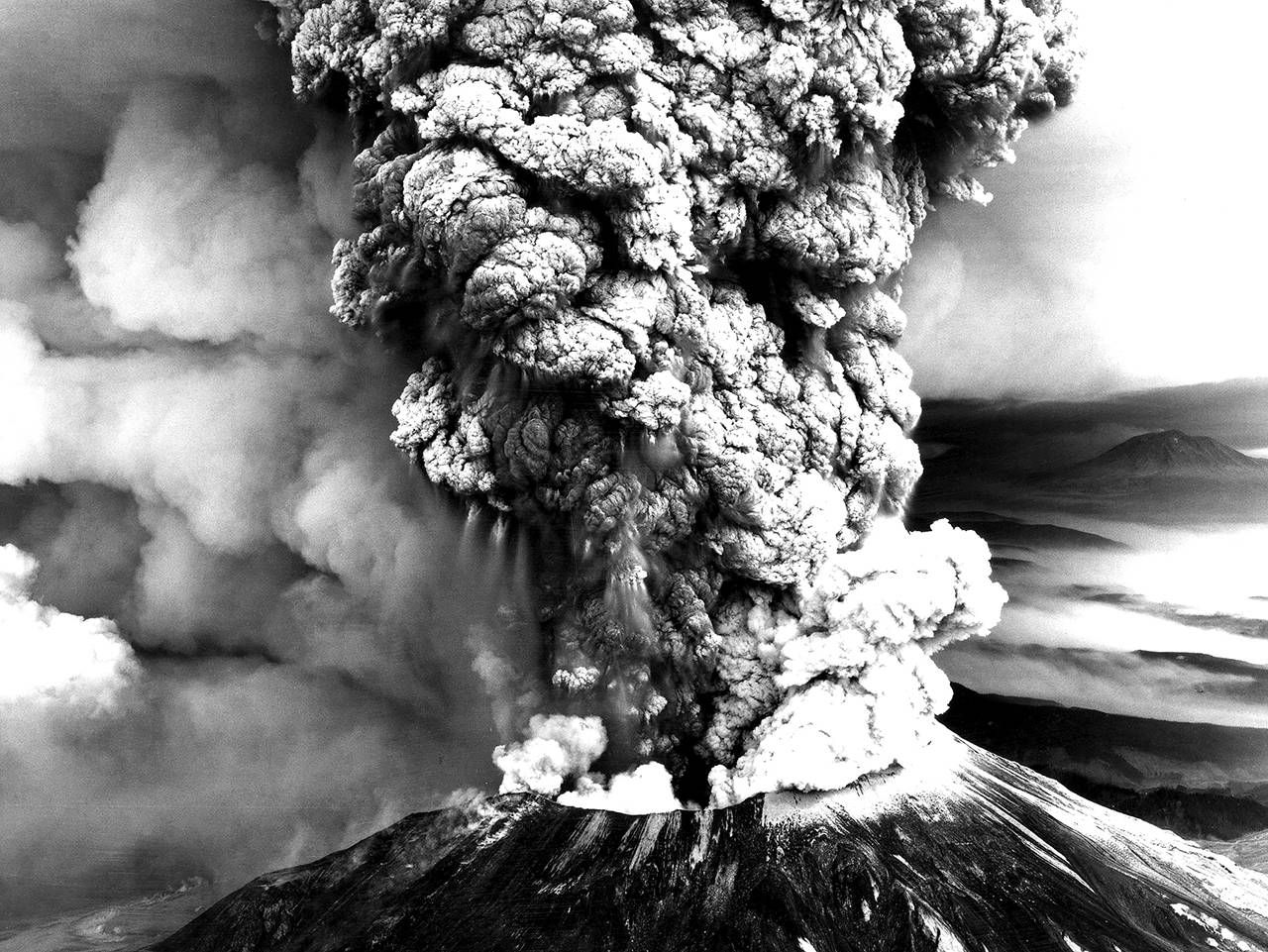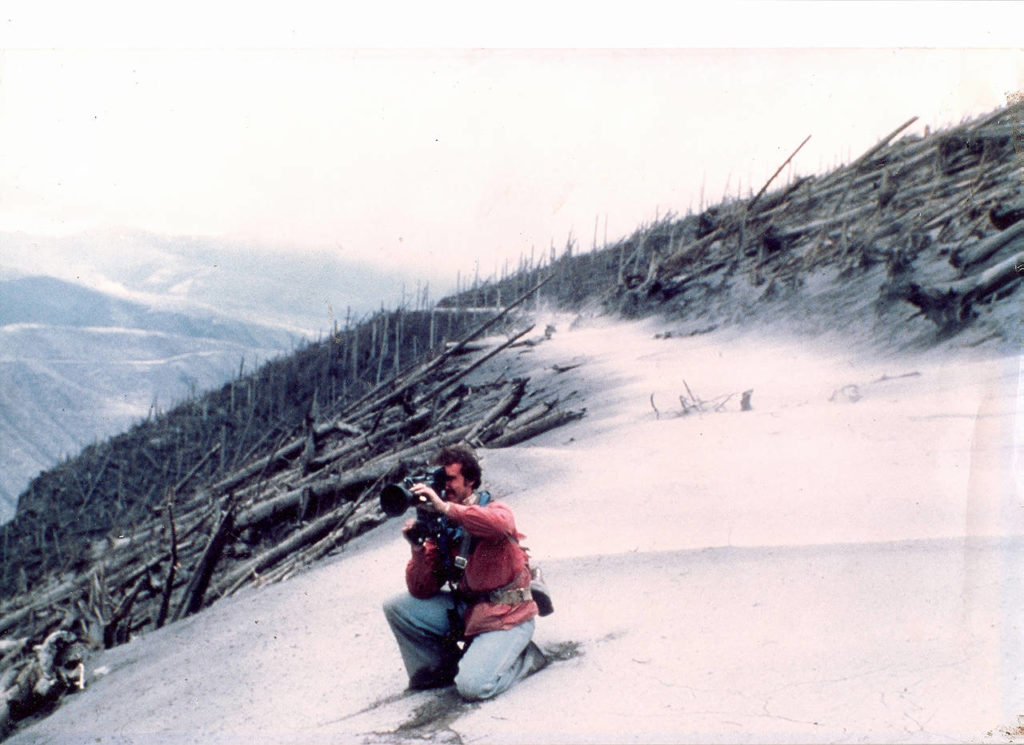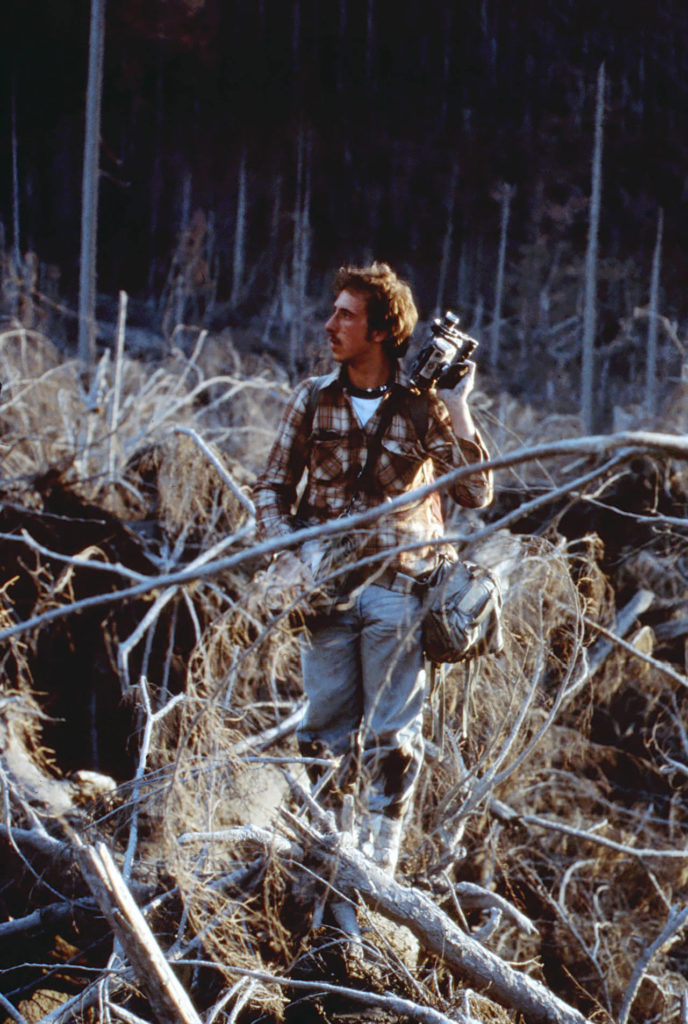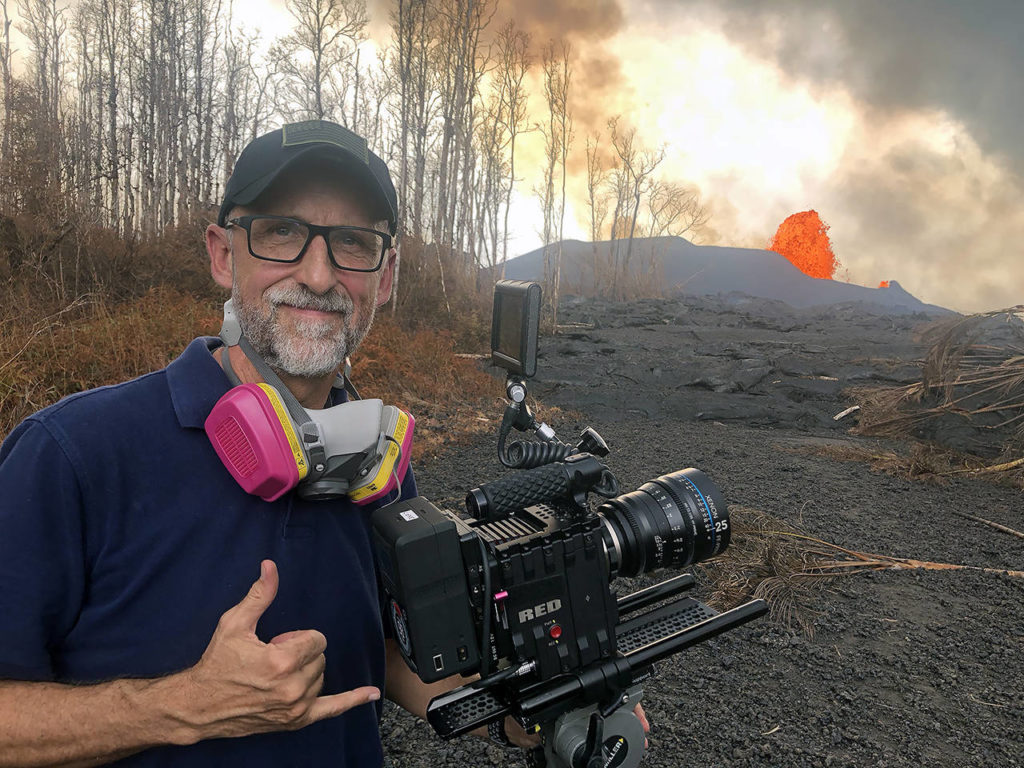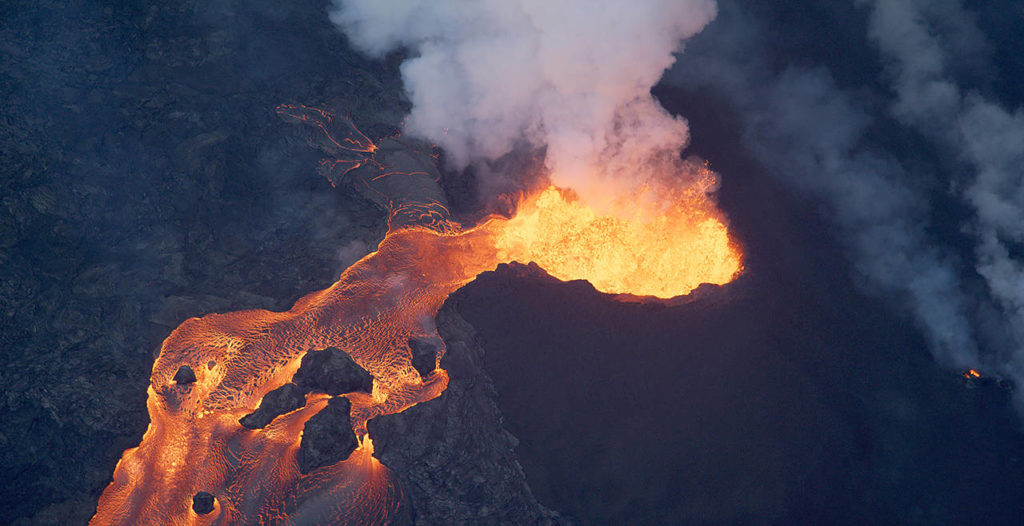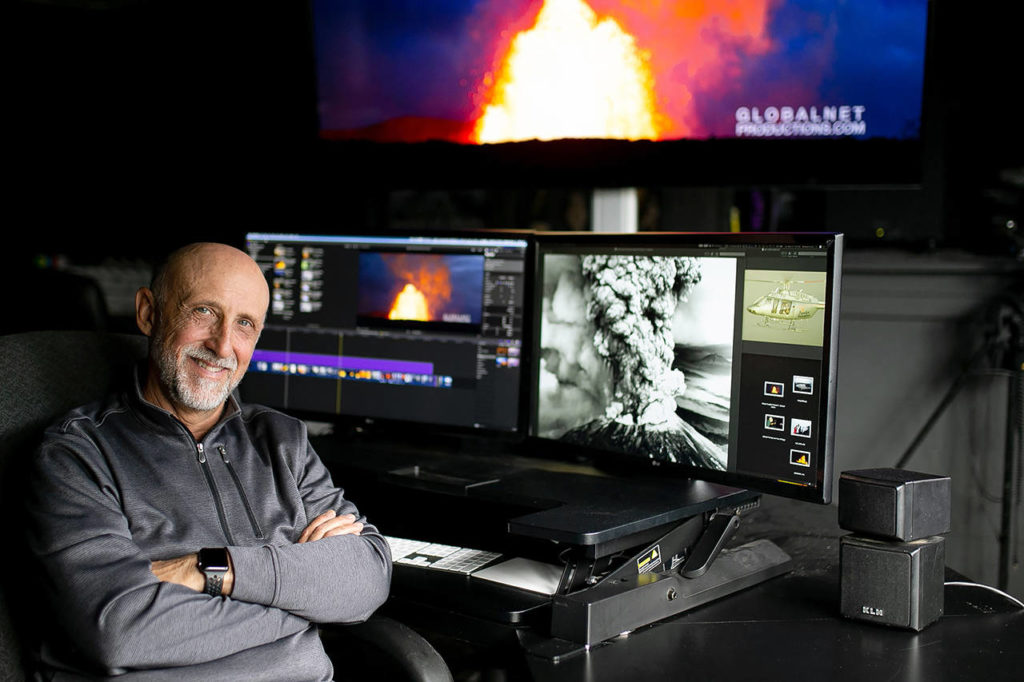Forty years ago, Michael Lienau was 20, a young man bent on a moviemaking career in Hollywood. Mount St. Helens, and his survival there just days after its catastrophic eruption, rewrote that script.
“Mount St. Helens is what changed my life,” said Lienau, now a 60-year-old filmmaker and father of nine living on Camano Island. “It was very humbling.”
Lienau is the producer and director of “The Fire Below Us: Remembering Mount St. Helens,” a 1997 documentary which aired on National Geographic’s Explorer TV series. Global Net Productions, the company he heads, also created “Cascadia: The Hidden Fire,” featured on PBS, and a number of other films.
He’s a good storyteller focused on real-world disaster and survival — with a compelling tale of his own.
By 1980, Lienau’s camera work had already been aired on TV news. Raised in Klamath Falls, Oregon, his love of filmmaking started at age 9. He used a Kodak Brownie 8mm movie camera. By 17, he was shooting news footage for KVAL, a TV station in Eugene. And there were those big-time Hollywood dreams.
“Then May 18 happened,” Lienau recalled Tuesday.
A once picture-perfect 9,677-foot peak in southwest Washington, often called the Mount Fuji of America, St. Helens blew its top when it erupted on May 18, 1980.
At 8:32 a.m. that Sunday, according to the U.S. Geological Survey, a magnitude 5.1 earthquake “was accompanied by a rapid series of events.” The volcano’s northern bulge and summit slid away in “a huge landslide — the largest debris avalanche on Earth in recorded history,” the USGS said. Ash rose from the base of the avalanche, and another plume spewed from the summit crater.
The mountain’s northern flank was gone, along with a dome that had grown inside the volcano. The dome’s destruction triggered lateral blasts, so powerful that hot material shot out at 300 miles an hour. Within 15 minutes, an eruption cloud had risen 80,000 feet in the air, a height of about 15 miles. And 1,300 feet of the summit had disappeared.
The human toll — 57 lives lost — included David Johnston, a USGS volcanologist; three members of a logging crew with one survivor, Jim Scymanky; and Harry Randall Truman, the 83-year-old owner and caretaker of a Spirit Lake lodge. As the place he loved attracted global attention with its volcanic activity, Truman had vowed he’d never leave.
Nearly a volcano victim
Lienau lives each day with the knowledge that he could have been one of St. Helens’ victims.
Less than a week after the eruption, he joined a film crew headed to the destruction zone. Flying by helicopter out of Boeing Field, the crew led by Otto Sieber landed on the outskirts of the debris area. They were to meet at another site to fly out. It was to have been a day trip.
“Harry Truman and his lodge, we wanted to find what had happened,” Lienau said. Instead, they bcame terribly lost — with just a day’s supply of food.
“There were five of us. I was the youngest,” said Lienau. Their compasses were spinning wildly because of magnetic particles in the volcanic dust. Maps, too, proved useless. The contours of the land had changed.
Disoriented, dispirited and engaged in what Lienau said were some “strong disagreements,” they were exhausted by a failed effort to reach their rendezvous spot.
Lienau remembers what he described in “The Fire Below Us” as “a deathly quiet.” Accustomed to being in forests, he was struck by the eerie absence of sound, from wind in the trees to birdsong, insects or animals.
“It was so quiet we thought a vampire could jump out,” said Lienau, who recalled seeing the carcasses of deer and elk.
The camera crew was still on the ravaged mountain May 25, 1980, when a smaller explosive eruption occurred. “We were a few miles from it,” he said on the film, in which he described “brilliant flashes of color.”
The aftermath of that May 25 blast brought air heavily laden with ash, followed by rain that helped them breathe easier. By then, what began as a photo mission had turned to one of survival.
Lienau remembers the nights as icy cold, and getting by on slim rations.
“We were suffering, and very ill prepared,” he said. “I had one little baggie of gorp and a canteen. Fresh water was coming from the side of the volcano, ice and snow melt.”
Simple prayers
Growing up, Lienau said he went to church on Sundays with his family, “but there was not much thought to my faith — until Mount St. Helens.”
While stranded on the volcano, the real possibility of death at age 20 caused him to take a hard look at his life. He believed in heaven and hell. He wondered, if he died, which one awaited him.
He later learned that by their third day away, families had been called and told they were presumed dead. “It slowly dawned on us that we were becoming our own story,” Lienau said in the film.
Lienau remembers others in the group turning to faith, and saying “very simple foxhole prayers.” His own was “God, help!”
A couple days after the May 25 blast, they were setting up camp and starting a fire when prayers were answered. He saw a rescue helicopter in the sky. Was it real?
After they were spotted and rescued, Lienau vowed he’d never forget that lesson in faith.
The hoped-for Hollywood film career was no longer important. Instead, Lienau went on to employ filmmaking to tell stories about nature’s power and survival, human-caused disasters, and of how people can prepare for emergencies.
One film project, “Yokes and Chains: A Journey to Forgiveness and Freedom,” tells of an international group’s expedition to retrace former slave routes, and of the racism still faced by descendants of slaves.
Mount St. Helens “just shifted my life,” he said. Along with that powerful lesson in faith, the volcano told him to “just enjoy life.” He and his wife, Shari, have nine children, among them five who were adopted, and are awaiting their fifth grandchild.
Lava and preparation
Lienau’s harrowing time on Mount St. Helens wasn’t his last encounter with a volcano. With friends and film projects in Hawaii, he and his family lived there from 2012 to 2019. The dramatic eruption of Kilauea, on the Big Island, gave him the chance to see and capture on film what even St. Helens hadn’t delivered.
He witnessed lava fountains and rivers of molten rock on the island of Hawai’i after Kilauea’s 2018 eruption. Seeing lava flow had been a fascination dating back to boyhood, when he’d watched geology films in school.
“It was over the top,” he said. Although Kilauea is a young and active volcano, Lienau said a spectacle such as its 2018 eruption “won’t happen again for maybe 400 years.”
The Kilauea experience was an up-close look at the importance of emergency preparedness, a subject Lienau has covered in his short films. “Three friends lost homes living in Hawaii’s lava zone,” he said.
Our Northwest is part of the Pacific Ring of Fire, known for its volcanoes, plate boundaries and earthquake activity. Among Lienau’s films is one titled “Living With Risk: Earthquakes in America,” a project that had scientists’ findings of 41 states living with the prospect of destructive earth shaking.
Lienau’s short educational films include “Business Survival Kit,” “Personal Survival Kit” and, yes, one made a decade ago called “Pandemic Survival Kit,” which includes President Barack Obama speaking about swine flu.
At the time, “nobody was interested” in his pandemic film, said Lienau, who thinks COVID-19 is a tough reminder that disaster preparedness is crucial.
“We’ve got to learn,” he said. “I’m not a prepper” stockpiling tons of supplies, “but when coronavirus hit, we had N95 masks and basic kits.” For his family, it means a month’s worth of food, with plenty of rice and beans, and a three-day supply in their cars.
“Don’t count on the government to take care of you,” Lienau said.
After 40 years, he sees an enduring interest in Mount St. Helens. Hurricanes and tornadoes claim more lives, but they’re expected. St. Helens was not only “a very unusual event that happened in our lifetime,” it was practically in our back yards.
“Mount St. Helens was a wake-up call,” he said.
Julie Muhlstein: 425-339-3460; jmuhlstein@heraldnet.com.
Learn more online
— Information about Michael Lienau’s films: www.globalnetproductions.com/
— The Pacific Northwest Seismic Network will present a webinar, “Mount St. Helens and the Cascade Range Volcanoes,” at 6:30 p.m. Monday: www.youtube.com/user/pnsnseisinfo
Moderated by seismic network Director Harold Tobin, the program will feature Jackie Caplan-Auerbach of Western Washington University, Josef Dufek of the University of Oregon, Seth Moran of the U.S. Geological Survey, and Steve Malone of the University of Washington. It will be followed at 8 p.m. Monday by a question-and-answer session: www.facebook.com/thePNSN/
— “40th Eruption Anniversary Virtual Story Circle: Voices of the Mount St. Helens Community,” presented by Washington State Parks and the Washington State Historical Society, will feature a ranger program, first-person stories, and instructions for making a volcano hat. It’s scheduled for 6:30-8:30 p.m. Monday at: www.facebook.com/historymuseum/live/
Talk to us
> Give us your news tips.
> Send us a letter to the editor.
> More Herald contact information.
